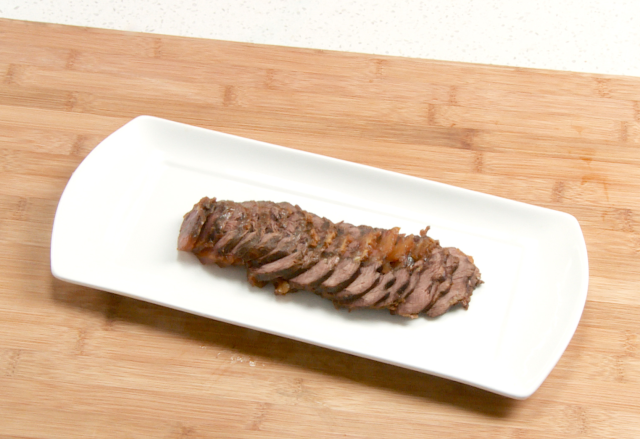Braised beef(卤牛肉)
Braised beef(卤牛肉) is a classic Chinese dish made with beef shank, slow-cooked to tender perfection, resulting in rich, flavorful meat with a deep, savory taste. This dish has a vibrant red color and an enticing aroma, making it an ideal choice for family gatherings or weekend dinners. Whether served with rice or as a cold appetizer, it promises a delightful culinary experience.


 18 Comments
18 Comments
When preparing this delicious braised beef, several key steps and techniques are crucial to ensure that you achieve the best possible result with this classic dish.
1.Choosing and Substituting Ingredients:
Beef Cuts: Opt for beef shank, which contains connective tissue that releases gelatin when cooked, adding to the dish’s texture. If beef shank is unavailable, you can substitute it with beef short ribs or chuck, but adjust the cooking time accordingly.
Spices: Cinnamon sticks, star anise, and bay leaves are essential for the braising liquid. If these aren’t accessible, substitute cinnamon sticks with ground cinnamon (use less), and replace star anise and bay leaves with Chinese five-spice powder in moderation.
Soy Sauce: Use dark soy sauce for color and flavor, and light soy sauce for seasoning. If light soy sauce is hard to find, use regular soy sauce but reduce the quantity to avoid over-salting.
2.Choosing and Substituting Cooking Tools:
Braising Pot: A clay pot is ideal for maintaining even heat. If you don’t have one, a cast-iron Dutch oven or a heavy-bottomed stainless steel pot will work well. If using an electric pressure cooker, reduce the cooking time to 30-40 minutes, but be cautious not to overcook the beef.
Cutting Tools: Use a sharp kitchen knife to slice the beef, ensuring even cuts through the connective tissue. If your knife isn’t sharp enough, lightly freeze the beef for 10 minutes before cutting to make slicing easier.
3.Key Cooking Steps:
Blanching: Bring water to a boil before adding the beef to remove blood and impurities. Use enough water to cover the beef fully, and blanch for just 3 minutes to maintain the beef’s tenderness.
Seasoning and Tasting: When making the braising liquid, start by adding a small amount of soy sauce and sugar, tasting as you go, and adjust gradually. Balancing salt and sugar is essential; if unsure, cool a spoonful of the broth and taste it before making adjustments.
Simmering and Heat Control: Keep the heat low during simmering to prevent the liquid from evaporating too quickly, which can toughen the beef. If needed, add hot water to keep the beef submerged in the liquid. Stir the beef occasionally to ensure even seasoning.
4.Preparation and Storage:
Advance Preparation: For deeper flavor, blanch the beef and refrigerate it in the braising liquid overnight, then simmer it the next day. This allows the beef to absorb more flavors and enhances the overall taste.
Cooling and Storage: After simmering, allow the beef to cool in the braising liquid to soak up the flavors further. Store the beef with the liquid in an airtight container in the refrigerator for 3-5 days. You can also freeze sliced beef, packaged separately, for future use; simply thaw and reheat when needed.
5.Side Dishes and Pairing Suggestions:
Side Dish Selection: Pair braised beef with fresh greens like water spinach, spinach, or Chinese broccoli for added fiber and vitamins. If desired, add carrots or potatoes to the braise; they’ll absorb the flavors and make a delicious side dish.
Pairing Options: Braised beef pairs wonderfully with steamed rice, mantou (Chinese steamed buns), or noodles, soaking up the rich braising sauce. It also works as a cold appetizer, sliced thin and dipped in garlic soy sauce or chili paste for an extra kick.
6.More Delicious Beef Recipes
If you enjoyed this flavorful braised beef recipe, you won’t want to miss these other beef dishes. These recipes are tasty, easy to make, and perfect for your next gathering!
Delicious Hunan Beef Stir-FryThese detailed tips and techniques will help kitchen beginners successfully make braised beef, from ingredient selection to the use of cooking tools, to seasoning and simmering, ensuring a final product that is tender, juicy, and full of flavor.
INGREDIENTS
MAIN INGREDIENTS
- 1.75 pounds (800g) beef shank, cut in half
ACCESSORIES
- 1 small piece of ginger, sliced
- 2 green onions (white parts only), cut into 2-inch pieces
- 3 cinnamon sticks (about 2-inch each)
- 3 star anise
- 3 bay leaves
SEASONINGS
- 2 tablespoons dark soy sauce
- 4 tablespoons light soy sauce
- 2 tablespoons cooking wine
- 1 teaspoon salt
- 1 teaspoon sugar
- Some cooking oil
- Some water
DIRECTIONS
STEP 1
Prepare Ingredients:
Cut 1.75 pounds (800g) of beef shank in half.
Slice 1 small piece of ginger.
Cut the white parts of 2 green onions into 2-inch pieces.

STEP 2
Blanch the Beef:
Bring a large pot of water to a boil. Add the beef shank and blanch for about 3 minutes. Flip the beef halfway through to ensure even cooking. Remove the beef and set it aside.

STEP 3
Prepare the Aromatics:
In a large pot, heat a bit of oil over medium heat. Add the sliced ginger and green onion pieces. Sauté for a minute until fragrant. Then, add the cinnamon sticks, star anise, and bay leaves. Stir for another minute to release the aromas.

STEP 4
Make the Braising Liquid:
Add enough water to the pot to cover the beef (about 4 cups). Stir in the cooking wine, salt, sugar, dark soy sauce, and light soy sauce. Bring to a boil.

STEP 5
Braise the Beef:
Transfer the blanched beef shank into a slow cooker or heavy-bottomed pot. Pour the hot braising liquid over the beef. Cover and simmer on low heat for 1.5 to 2 hours, until the beef is tender and the flavors are well absorbed.

STEP 6
Cool and Serve:
Once cooked, allow the beef to cool in the liquid for a more intense flavor. When ready to serve, remove the beef, slice it thinly, and arrange it on a plate. Enjoy!

Recipe analyzer
- Recipes: Braised beef(卤牛肉)
- Main Ingredients:6
- Servings per recipe:1
- Servings size:1.5 kg
-
Energy (calories):1230 kcal
-
Protein:177.99 g
-
Fat:31.11 g
Why gray?

-
Carbohydrates:50.37 g
-
Protein: 61%752 kcal
-
Fat: 23%280 kcal
-
Carbohydrates: 16%193 kcal

The ratio shows whether the proportion of both fatty acids in your diet is optimal. Red color means too much of Omega 6 or too little of Omega 3. The data are rounded off and approximate.











18 REVIEWS